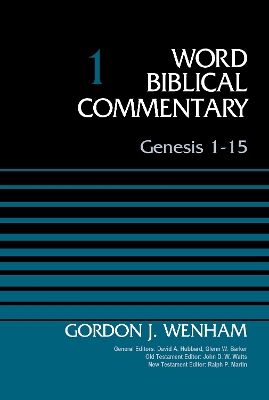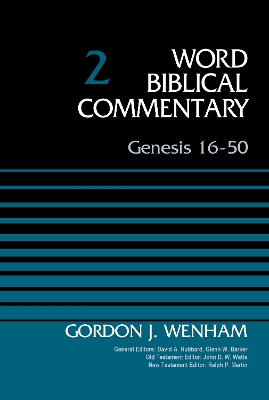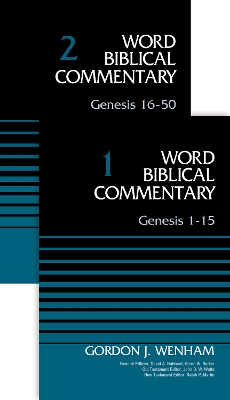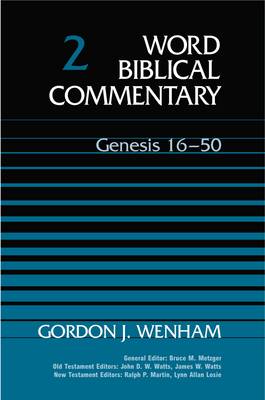Word Biblical Commentary
5 total works
The Word Biblical Commentary delivers the best in biblical scholarship, from the leading scholars of our day who share a commitment to Scripture as divine revelation. This series emphasizes a thorough analysis of textual, linguistic, structural, and theological evidence. The result is judicious and balanced insight into the meanings of the text in the framework of biblical theology. These widely acclaimed commentaries serve as exceptional resources for the professional theologian and instructor, the seminary or university student, the working minister, and everyone concerned with building theological understanding from a solid base of biblical scholarship.
Overview of Commentary Organization
- Introduction—covers issues pertaining to the whole book, including context, date, authorship, composition, interpretive issues, purpose, and theology.
- Each section of the commentary includes:
- Pericope Bibliography—a helpful resource containing the most important works that pertain to each particular pericope.
- Translation—the author’s own translation of the biblical text, reflecting the end result of exegesis and attending to Hebrew and Greek idiomatic usage of words, phrases, and tenses, yet in reasonably good English.
- Notes—the author’s notes to the translation that address any textual variants, grammatical forms, syntactical constructions, basic meanings of words, and problems of translation.
- Form/Structure/Setting—a discussion of redaction, genre, sources, and tradition as they concern the origin of the pericope, its canonical form, and its relation to the biblical and extra-biblical contexts in order to illuminate the structure and character of the pericope. Rhetorical or compositional features important to understanding the passage are also introduced here.
- Comment—verse-by-verse interpretation of the text and dialogue with other interpreters, engaging with current opinion and scholarly research.
- Explanation—brings together all the results of the discussion in previous sections to expose the meaning and intention of the text at several levels: (1) within the context of the book itself; (2) its meaning in the OT or NT; (3) its place in the entire canon; (4) theological relevance to broader OT or NT issues.
- General Bibliography—occurring at the end of each volume, this extensive bibliography contains all sources used anywhere in the commentary.
The Word Biblical Commentary delivers the best in biblical scholarship, from the leading scholars of our day who share a commitment to Scripture as divine revelation. This series emphasizes a thorough analysis of textual, linguistic, structural, and theological evidence. The result is judicious and balanced insight into the meanings of the text in the framework of biblical theology. These widely acclaimed commentaries serve as exceptional resources for the professional theologian and instructor, the seminary or university student, the working minister, and everyone concerned with building theological understanding from a solid base of biblical scholarship.
Overview of Commentary Organization
- Introduction—covers issues pertaining to the whole book, including context, date, authorship, composition, interpretive issues, purpose, and theology.
- Each section of the commentary includes:
- Pericope Bibliography—a helpful resource containing the most important works that pertain to each particular pericope.
- Translation—the author’s own translation of the biblical text, reflecting the end result of exegesis and attending to Hebrew and Greek idiomatic usage of words, phrases, and tenses, yet in reasonably good English.
- Notes—the author’s notes to the translation that address any textual variants, grammatical forms, syntactical constructions, basic meanings of words, and problems of translation.
- Form/Structure/Setting—a discussion of redaction, genre, sources, and tradition as they concern the origin of the pericope, its canonical form, and its relation to the biblical and extra-biblical contexts in order to illuminate the structure and character of the pericope. Rhetorical or compositional features important to understanding the passage are also introduced here.
- Comment—verse-by-verse interpretation of the text and dialogue with other interpreters, engaging with current opinion and scholarly research.
- Explanation—brings together all the results of the discussion in previous sections to expose the meaning and intention of the text at several levels: (1) within the context of the book itself; (2) its meaning in the OT or NT; (3) its place in the entire canon; (4) theological relevance to broader OT or NT issues.
- General Bibliography—occurring at the end of each volume, this extensive bibliography contains all sources used anywhere in the commentary.
The Word Biblical Commentary delivers the best in biblical scholarship, from the leading scholars of our day who share a commitment to Scripture as divine revelation. This series emphasizes a thorough analysis of textual, linguistic, structural, and theological evidence. The result is judicious and balanced insight into the meanings of the text in the framework of biblical theology. These widely acclaimed commentaries serve as exceptional resources for the professional theologian and instructor, the seminary or university student, the working minister, and everyone concerned with building theological understanding from a solid base of biblical scholarship.
Overview of Commentary Organization
- Introduction - covers issues pertaining to the whole book, including context, date, authorship, composition, interpretive issues, purpose, and theology.
- Each section of the commentary includes:
- Pericope Bibliography - a helpful resource containing the most important works that pertain to each particular pericope.
- Translation - the author’s own translation of the biblical text, reflecting the end result of exegesis and attending to Hebrew and Greek idiomatic usage of words, phrases, and tenses, yet in reasonably good English.
- Notes - the author’s notes to the translation that address any textual variants, grammatical forms, syntactical constructions, basic meanings of words, and problems of translation.
- Form/Structure/Setting - a discussion of redaction, genre, sources, and tradition as they concern the origin of the pericope, its canonical form, and its relation to the biblical and extra-biblical contexts in order to illuminate the structure and character of the pericope. Rhetorical or compositional features important to understanding the passage are also introduced here.
- Comment - verse-by-verse interpretation of the text and dialogue with other interpreters, engaging with current opinion and scholarly research.
- Explanation brings together all the results of the discussion in previous sections to expose the meaning and intention of the text at several levels: (1) within the context of the book itself; (2) its meaning in the OT or NT; (3) its place in the entire canon; (4) theological relevance to broader OT or NT issues.
- General Bibliography - occurring at the end of each volume, this extensive bibliography contains all sources used anywhere in the commentary.
v. 1
Wenham displays unusual sensitivity to the compositional artistry of Genesis and the importance of storytelling in God's self-revelation to the human family. Dr. Wenham shows the opening chapters of Genesis as describing an avalanche of sin that gradually engulfs mankind-the alienation of the first man and woman and their expulsion from the presence of God in the garden, mankind's near-annihilation in the flood, the folly of Babel and humanity's dispersal over the face of the globe teaching that without God's blessing mankind is without hope. "But the promises to Abraham and the patriarchs begin to repair that situation," says Dr. Wenham. "The covenant will benefit not just Abraham and his descendants, but in him all the nations of the earth will find blessing, and the ultimate fulfillment of the creator's ideals for humanity is guaranteed ...Let us beware of allowing ourselves to be diverted from the central thrust of the book so that we miss what the Lord, our creator and redeemer, is saying to us."
v. 2
Out of his extensive examination of Genesis 16-50, Dr. Wenham has produced a careful commentary that interacts with contemporary scholarship in a restrained, informed manner, clearly affirming from beginning to end his underlying conclusions: * that the patriarchal stories contained in Genesis are not pagan god-myths born in the Canaanite culture but, instead, are records that deal with real historical figures; * that the multi-century oral transmission of the history is accurate and believable; * that uncertainties about dating the patriarchal period in Genesis are not too great to keep scholars from placing these events in the centuries shortly after 2000 B.C.E.; * that the Genesis picture of patriarchal life matches what we know about the family names, tribal customs, social laws, and domestic arrangements of the second millennium B.C.E. Gordon Wenham has produced a commentary destined to take a respected place in all critical studies of Genesis, challenging liberal and conservative readers alike to pay closer attention to what the Bible tells us. Serious students of Genesis will applaud Dr.
Wenham's fine commentary as a genuine aid for all who seek to unravel the mysteries of Scripture and to know the mind of God.




